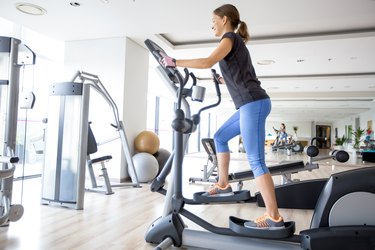
Located on the upper side of your thigh, the tensor fasciae latae, or TFL, is enclosed between layers of fascia, or fibrous tissue. This muscle works with the iliopsoas to flex your hip forward and with the gluteus medius and minimus muscles to abduct your hip out to the side.
The tensor fasciae latea, as explained by ExRx.net, plays a key role in hip and knee stability as well. Keep this muscle strong with tensor fasciae latae exercises.
Video of the Day
Video of the Day
Tip
Add the stair climber, cable strengthening and hip abductor machines, and parallel bars to your TFL workout.
Read more: The Best and Worst Exercises for Bad Hips
1. Stair Climber Machine
Stair climber machines come in various forms, but they all use the same basic concept — repetitive hip flexion. This flexion works your tensor fasciae latae and iliopsoas muscles in a continuous manner.
If you're one of many who have weak hip flexors, you will feel obvious fatigue in the front of your hips after several minutes of stair climbing during your TFL workout. With most stair climbers, you simply step onto the machine and begin to climb or push the power button to begin. Adjust the resistance and speed of the machine to match your fitness level.
2. Cable Machine
Cable machines can be used to work both flexion and abduction as part of your tensor fasciae latae workout, as demonstrated by the American Council on Exercise. The resistance provided by a cable machine will significantly strengthen the muscles of your hips.
Move 1: Hip Abduction
- Stand with your left side facing the machine.
- Attach the ankle cuff to your right ankle and transfer your weight to your left leg.
- Pull against the cable to lift your right leg out to the side as high as possible.
- Pause at the top of the movement; then carefully lower to the starting position.
Move 2: Hip Flexion
The standing cable raise works your tensor fasicae latae through hip flexion.
- Begin with your back toward the machine.
- Attach the ankle cuff to your right ankle, take a step forward with your left foot and transfer your weight to your left leg.
- Pull against the cable to pull your right knee forward and up until it reaches hip level.
- Slowly return to the starting position.
3. Hip Abductor Machine
The hip abductor machine comes in two forms: standing and seated, as demonstrated by ExRx.net. Both types of machines allow you to perform the same exercise. Use this machine to work your tensor fasciae latae and develop your gluteal muscles.
- Sit on the machine seat with your back snug against the back rest.
- Adjust the resistance on the machine to your fitness level.
- Position your legs in the pads and slowly press your legs against the pads to spread them as wide as possible.
- Pause and then carefully return to the starting position.
Read more: 4 Tips for Getting Rid of Hip Flexor Pain
4. Parallel Bars
Parallel bars are most often used to work the arms and abdomen but are also great for working the muscles responsible for hip flexion, as demonstrated by the Australian College of Sport & Fitness. When you use this machine, you can use your own body weight or opt for additional resistance by holding a dumbbell between your feet.
- Place your forearms on padded parallel bars.
- Grasp the handles and press your back into the vertical pad.
- Begin with your legs hanging straight down.
- Keeping your legs together, raise your knees as high as possible by flexing your hips.
- Lower your legs back down until your hips are completely extended.